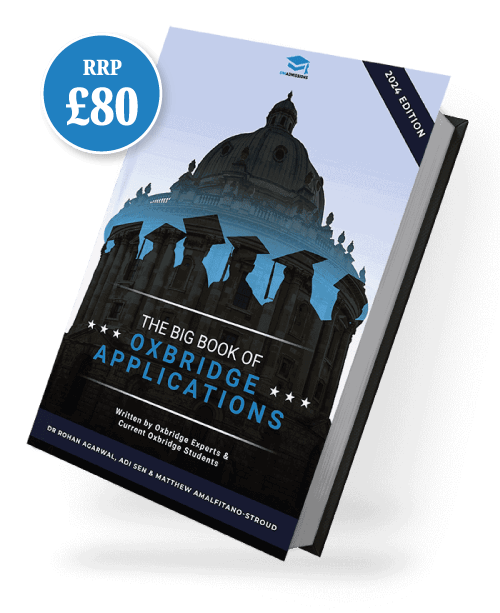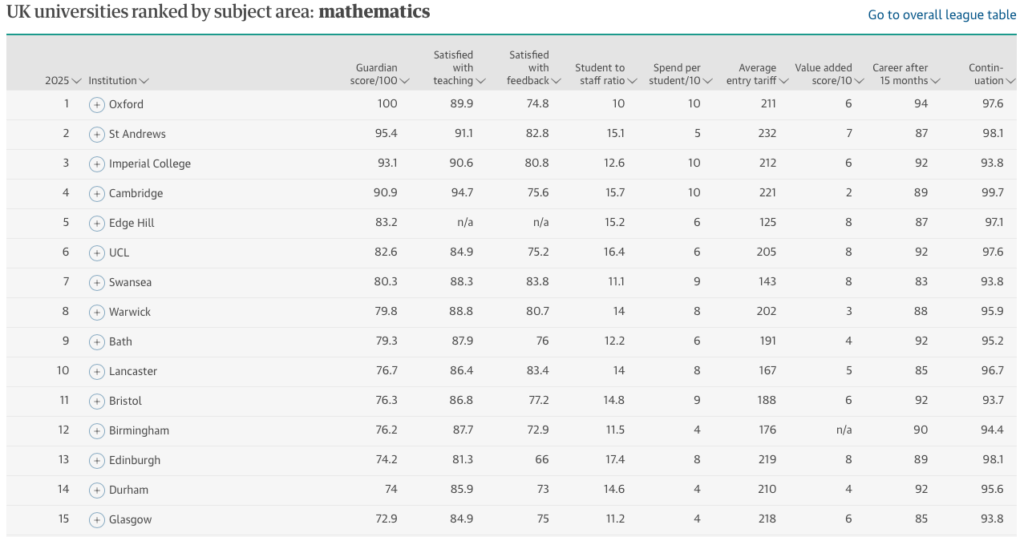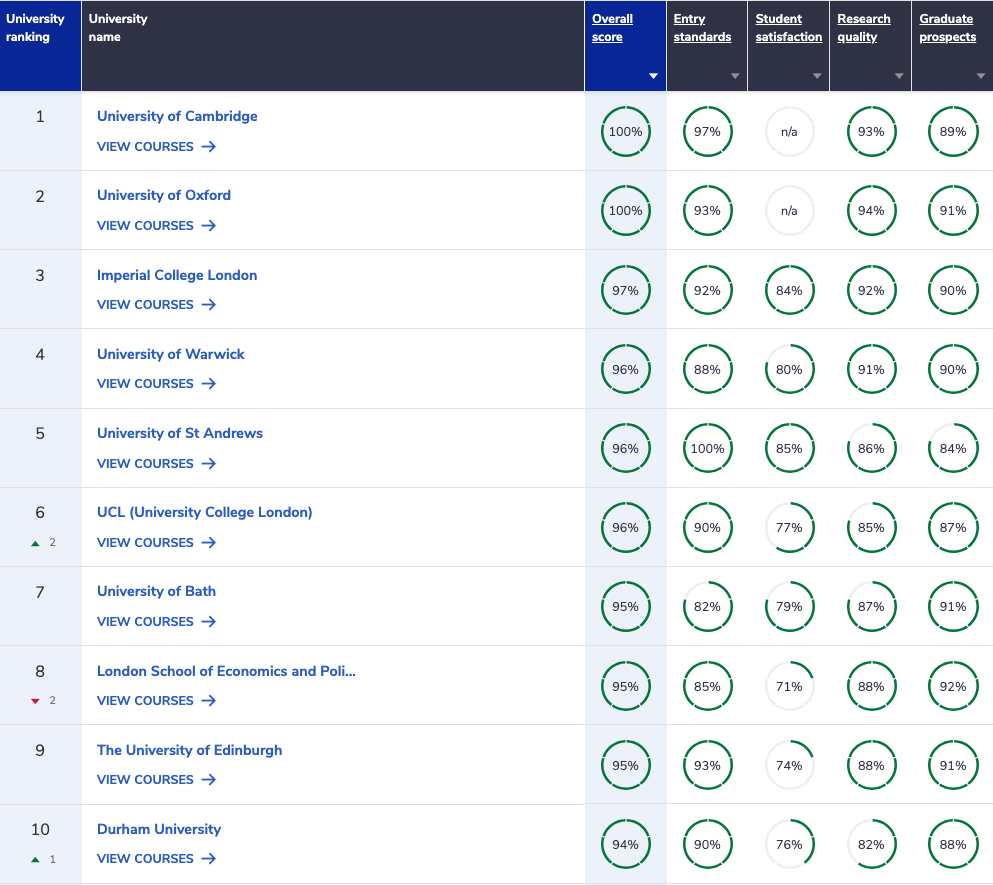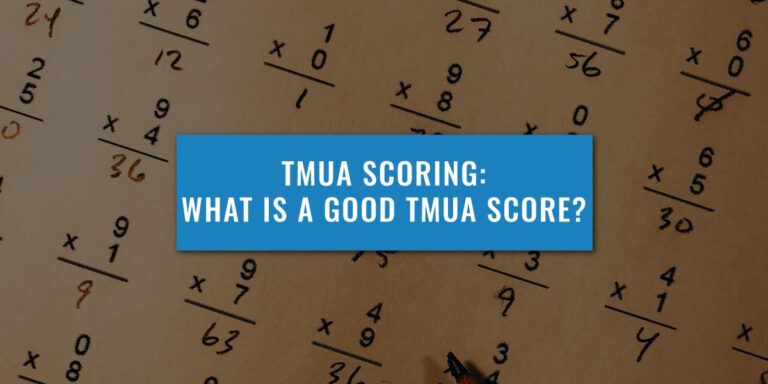If you’re finding it difficult to find a university that best suits you, you may be researching university ranking tables. These are a great way to easily compile large amounts of data and research into a simple, numerical ranking system.
Ranking tables are available for all major subjects taught in the UK and base their placements on a variety of factors that would impact a student’s life and studies. However, while these are very useful tools, they aren’t perfect and should be taken with a grain of salt.
In this guide, we’ll explore the two main ranking tables for universities in the UK to see which Mathematics degrees are considered the best. We’ll also see how rankings should best be used to ensure that you make the best decision when picking your university. Let’s begin.
Who Makes The Mathematics rankings?
Firstly, who actually makes these lists? While there are various different ranking organisations that create lists, there are two in the UK that are more trusted and widely considered than any other; The Guardian and The Complete University Guide.
While these two are the most popular, they aren’t the only ones available and aren’t definitively correct about their placements. These tables are based on data but this data can be interpreted differently, which is why different tables can have different placements rather than being identical to one another.
With that being said, let’s take a close look at how each of these organisations create their tables.
Want to secure your place to study Mathematics at Oxbridge?
Writing the perfect Personal Statement, scoring highly on your admissions test and interviewing like a pro is how you get your dream Oxbridge Mathematics offer.
Discover our Full-Blue Mathematics Programme for comprehensive admissions support by clicking the button below to enrol and triple your chances of success.
The Guardian Mathematics Rankings
To compile their list of Mathematics courses in the UK, The Guardian uses the following headings:
Guardian score/100 – rating of excellence based on a combination of the other factors.
Satisfied with the course – the rating of the overall quality of the course, given by final-year students in the latest National Students Survey (NSS) given as a percentage.
Satisfied with the teaching – the rating of the quality of teaching on the course given by final-year students in the latest NSS.
Satisfied with feedback – the rating of the feedback and assessment, given by final-year students in the latest NSS.
Student to staff ratio – number of students per member of teaching staff.
Spend-per student/10 – money spent on each student, excluding academic staff costs, given as a rating out of ten.
Average entry tariff – typical UCAS scores of young entrants to the department.
Value-added score/10 – this score compares students’ degree results with their entry qualifications, to show how effectively they are taught – given as a score out of ten.
Career after 15 months – percentage of graduates who find graduate-level jobs, or are in further study at professional or higher education level, within 15 months of graduation.
Continuation – percentage of first-year students continuing to second-year.
The Guardian bases the scores for each of these metrics on data collected from the National Student Survey (NSS) and the universities themselves. While this means that much of the ranking is based on subjective statistics, there is still a level of subjectivity that goes into the data interpretation. However, this doesn’t mean that the table is biased in any way as there is legitimate reason to view data in certain ways.
The Guardian Mathematics University Rankings 2025
Below are the top 25 entries of The Guardian’s league table, displaying the results for 2025 and a comparison to 2024’s results:
| Postition | University | Previous Position (2024) |
|---|---|---|
| 1 | University of Oxford | 1st (=) |
| 2 | University of St. Andrews | 2nd (=) |
| 3 | Imperial College London | 3rd (=) |
| 4 | University of Cambridge | 5 (>1) |
| 5 | Edge Hill University | 24 (>19) |
| 6 | University College London (UCL) | 7 (>1) |
| 7 | Swansea University | 14 (>7) |
| 8 | University of Warwick | 8 (=) |
| 9 | University of Bath | 9 (=) |
| 10 | Lancaster University | 10 (=) |
| 11 | University of Bristol | 18 (>7) |
| 12 | University of Birmingham | 32 (>20) |
| 13 | University of Edinburgh | 4 (<9) |
| 14 | Durham University | 19 (>5) |
| 15 | University of Glasgow | 11 (<4) |
| 16 | London School of Economics and Political Science (LSE) | 6 (<10) |
| 17 | University of Plymouth | 17 (=) |
| 18 | Keele University | 15 (<3) |
| 19 | Loughborough University | 19 (=) |
| 20 | Heriot-Watt University | 16 (<4) |
| 21 | University of Kent | 23 (>2) |
| 22 | University of Surrey | 31 (>9) |
| 23 | Aberystwyth University | 11 (<12) |
| 24 | University of Southampton | 21 (<3) |
| 25 | University of Essex | 13 (<12) |
Just like in 2024, the University of Oxford was ranked as the best Mathematics university by The Guardian, scoring a perfect 100. Coming fairly far behind in 2nd with a score 95.4 is St. Andrews, which is the only Scottish university to appear in the top ten. Interestingly, Cambridge only ranked 4th on this list despite the two Oxbridge universities typically sitting next to each other in rankings.
Two of the major Russell Group London-based universities appear in the top ten, Imperial and UCL. Despite this, King’s College London (sometimes considered a part of the G5 universities) appears at the end of the ranking at 60th, while LSE ranked 16th. Beyond these, Swansea, Warwick, Bath and Lancaster round out the bottom of the top ten, only one of which being a Russell Group university.
One thing to note about this ranking table is that the placements have been very volatile, with multiple major rises and falls since 2024. In the top 25, the largest gain was for the University of Birmingham, which rose 20 places from 32nd to 12th. Meanwhile, the biggest drop from 2024’s top 25 was for the University of Stirling, dropping 13 places from 24th to 37th.
The Complete University Guide Mathematics Rankings
Next up is the Complete University Guide. The table created by this organisation are actually based on similar data to The Guardian and covers roughly the same points, though the perspective and interpretation of these points is somewhat different.
Overall score – the total score calculated by The Complete University Guide’s independent and trusted methodology.
Entry standards – the average UCAS tariff of new students entering university.
Student satisfaction – a guide to how satisfied students are with the quality of teaching they receive.
Research quality – a measure of the quality of the research undertaken by the university.
Research intensity – a measure of the proportion of staff involved in high-quality research at the university.
Graduate prospects – outcomes – a guide to the success of graduates after leaving university.
Graduate prospects – on track – a measure of whether recent graduates agree that their current activity fits with their future plans.
Complete University Guide has fewer specific categories than The Guardian, but this is largely due to elements of the data being consolidated. As mentioned, the data for these lists is gathered in a similar manner to The Guardian, using data from the NSS and the universities.
Complete University Guide Mathematics University Ranking Table 2025
Below are the top 25 entries Complete University Guide ranking table, displaying the results for 2025 and a comparison to 2024’s results:
| Postition | University | Previous Position (2024) |
|---|---|---|
| 1 | University of Cambridge | 1st (=) |
| 2 | University of Oxford | 2nd (=) |
| 3 | Imperial College London | 3rd (=) |
| 4 | University of Warwick | 4th (=) |
| 5 | University of St. Andrews | 5th (<1) |
| 6 | University College London (UCL) | 8th (>2) |
| 7 | University of Bath | 7th (=) |
| 8 | London School of Economics and Political Science (LSE) | 6th (<2) |
| 9 | University of Edinburgh | 9th (=) |
| 10 | Durham University | 11th (>1) |
| 11 | University of Bristol | 10th (<1) |
| 12 | Lancaster University | 14th (>2) |
| 13 | University of Manchester | 13th (=) |
| 14 | University of Glasgow | 12th (<2) |
| 15 | Heriot-Watt University | 18th (>3) |
| 16 | Loughborough University | 15th (<1) |
| 17 | University of Birmingham | 20th (>3) |
| 18 | University of Exeter | 16th (<2) |
| 19 | University of Southampton | 17th (<2) |
| 20 | Queen’s University Belfast | 19th (<1) |
| 21 | University of Leeds | 26th (>5) |
| 22 | Aberystwyth University | 24th (>2) |
| 23 | Swansea University | 29th (>6) |
| 24 | University of Stirling | 30th (>6) |
| 25 | University of York | 21st (<4) |
In 2025, the Complete University Guide’s top ten universities are almost identical to the previous year. The only changes are the placements of various universities and the addition of Durham University, which rose one spot to replace Bristol (which ranked 11th this year).
The top ten here is also identical to The Guardian’s rankings in terms of entries, although placements are somewhat different. The biggest change is that Cambridge performed much better here to achieve the top spot over Oxford.
Throughout the rest of the top 25, there weren’t many drastic placement changes from last year, with many entries holding their position from 2024. The biggest increase came from both Swansea and Stirling, each rising 6 places, while the biggest drop came from York, falling 4 places to 25th.
Access "The Oxbridge Application Vault"
- 300+ page ebook for Oxbridge Applicants
- 25 page ebook for Personal Statement
- 2h+ online course to succeed in any exam
- Online Oxbridge Success Calculator
- 12 page ebook about UniAdmissions

Access "The Big Book Of Oxbridge Applications" For FREE
Considering studying Mathematics at Cambridge or Oxford? Download The Big Book Of Oxbridge Applications for free here to discover everything you need to know about Oxbridge Economics and its application process. Through over 350 pages, you’ll find:
- Over 40 admissions test practice questions
- 28 example Oxbridge Personal Statements
- Interviews with Oxbridge students and graduates
- Additional downloadable resources
Fill in your details below to claim your digital copy today!

The Best and Worst UK Universities For Mathematics
Now we’ve seen the rankings, it’s time to look at the tops and bottoms of each list to see which universities were ranked the best and worst. Please bear in mind that, while these universities received these places on the lists, university rankings aren’t a definitive statement of a university’s quality, nor do they provide official titles to said university.
With that being said, let’s take a look at the top five and bottom five entries of each table:
Best Universities For Mathematics UK
Between the two lists, we can see a fairly consistent top five. The universities featured are very commonly seen this high in both general and subject-specific rankings, so these lists doesn’t house many surprises.
Complete University Guide
- University of Cambridge
- University of Oxford
- Imperial College London
- University of Warwick
- University of St. Andrews
The Guardian
- University of Oxford
- University of St. Andrews
- Imperial College London
- University of Cambridge
- Edge Hill University
As you can see, four out of five entries are the same in each list (though with varying placements). Out of the two outliers, Warwick and Edge Hill, Warwick is a fairly common university to see high on ranking tables (it ranked 8th on The Guardian’s list).
However, Edge Hill is a more obscure pick for a top spot. The university, based in Ormskirk, doesn’t frequently rank highly and was not included at all in the Complete University Guide’s Mathematics ranking. It’s placements like these that prove that rankings are far from definitive, so always consider other factors alongside rankings when picking university options.

Worst Universities For Mathematics UK
As far as the rankings go, these are the worst universities for Mathematics in the UK. However, it’s important to recognise that these rankings aren’t definitive, partly because the rankings change each year and partly because these rankings don’t paint a full picture of what a course or university is like.
With that in mind, here are the lowest-ranked Mathematics universities in the UK in ascending order:
Complete University Guide
- University of Wolverhampton
- Northumbria University, Newcastle
- University of Hull
- Liverpool Hope University
- University of Hertfordshire
The Guardian
- King's College London
- City, University of London
- University of Reading
- Aston University
- University of Cardiff
As we can see, each entry in both lists is unique from one another. This is common for ranking tables, as there is rarely an agreed consensus on which university is worst for a specific subject.
Perhaps the most shocking aspect of these rankings is the Guardian’s placement of King’s College London at the bottom of their list at 60th. Despite being considered one of the top universities in London, KCL scored poorly, achieving just 31.9/100. It was ranked 33rd by Complete Uni Guide which, while still not too high, is far more generous than The Guardian’s appraisal.
Which Ranking Table Should I Follow?
Next, let’s tackle the question of which table you should follow. In reality, there isn’t really a set one you should consider over the other because the factors they’re considering are fairly similar. There also aren’t any specific biases or objectives within either ranking body, so neither list is trying to sway you in a certain direction.
That’s not to say that the lists are compiled identically, but the differences are more subtle. Ultimately, The Guardian’s ranking is largely based on student perspective while The Complete University Guide focuses on research, employment and student satisfaction.
While it’s easy to get caught up in trying to attend the highest-ranked university in the country, most universities in the UK teach to a high standard and provide excellent prospects for their graduates. Even lower-ranked universities will still provide you with a good degree, so you should be looking at other factors when choosing you university too.
For more data-driven decisions, it’s important to review the entry requirements and acceptance rates for your potential universities. Highly ranking universities like Oxford and Cambridge tend to have high entry requirements and low acceptance rates (13.8% at Oxford and 16.6% at Cambridge).
Beyond the statistics though, you also need to ensure that the university you’ll be attending is somewhere you actually want to live and work. Attending open days is a great way of assessing the area, exploring the facilities and meeting the staff and students there – all crucial elements to consider when picking a university.
Ultimately, it’s all about what you’re looking for from your university experience and beyond, so keep your options open when looking at potential choices.
Conclusion
So while we now know which universities were ranked the best and worst by the major organisation who study these things, we also know that these rankings aren’t the most important thing to consider when choosing our universities. There are other factors that will have a much more direct impact on your application and experience, so you should keep your options open, no matter what the ranking tables say.
The rankings are good for setting expectations and understanding which universities are popular and offer the best education, but also be aware that these top universities are highly competitive and, in some cases, just not worth it if you don’t appreciate the teaching style, campus or any other aspect of the institution. Make your decision based on what you want and can realistically achieve, and you’ll more than likely find the right fit for you. Good luck!
Worried about your Oxbridge chances? Our offer success rate is 59%
Applying to Oxbridge is immensely competitive and it is crucial that you give yourself the best chance of success. We help you craft the perfect Personal Statement, achieve a highly competitive Admissions Test score and teach you how to Interview effectively – covering all areas of your Oxbridge application.
Discover our Full-Blue Mathematics Programme now to learn how you can triple your chances of success.









